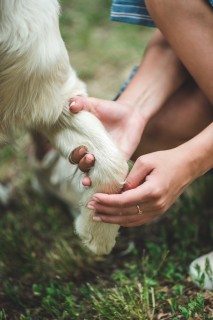Canine Sports Medicine
Once a year, I teach a class called Canine Sports Medicine for the Performance Dog Handler. It is not just for performance dog handlers. Anyone who has a dog that is active, that has had an injury, or that will have an injury, will benefit from this class.
Everyone wants to do the best for their dogs. Many of us are willing and able to travel several hours and spend several thousand dollars to treat our dog's injury. The problem is, if we don't know what is wrong, we can't fix it. In my experience, the weakest link in treating injuries in dogs is getting the correct diagnosis.
Orthopedic Evaluation vs The Sports Medicine Evaluation
Doing a thorough sports medicine evaluation is different from doing an orthopedic evaluation. In my surgery residency training, I learned how to examine the injured limb. We concentrated mostly on the bones and joints.
When I started doing sports medicine, I learned how to do a more thorough exam. I examine the whole dog: the neck, the back, and all four legs, no matter what leg is injured. I thoroughly evaluate not only the bones and joints, but the muscles, tendons, ligaments, and nerves.
Many times, we don't even know what leg is injured, or if it is a leg that is the problem. We have a history of a dog that is popping weaves, or knocking bars, or running 1-2 seconds slower than normal in agility, or running around the jump on the retrieve over the high jump, or not herding quite like she used to. Sometimes, the history is, "My agility instructor thinks something is wrong," or "My handler thinks my dog's gait is a little off," or "My dog hesitates slightly before she jumps." As a handler, I know these things are important. As a veterinarian, I take these concerns seriously. I know that 1 second in agility is an eternity!
Diagnosing Sports Injuries in Dogs
No matter how great your regular vet is, he/she may not have the training or experience to diagnose some of the common sports injuries we see in dogs. Also, some injuries are very subtle, and it takes time to do a thorough exam to check for tiny changes that may be causing the dog's problem.
Fortunately, as canine sports medicine becomes more and more requested by owners, more veterinarians are being trained in the field. They are still few and far between, and you may not know how to find them, but they are out there. You just have to know where to look.
Not every front leg lameness is a shoulder problem. Not every hind leg lameness is a cruciate ligament injury or iliopsoas strain.
There is a lot of dog between the tip of the nose and the end of the tail. Although some injuries are more common than others, almost anything can be sprained, strained, torn, broken, stretched, compressed, or contused. Once we have the correct diagnosis, the next hurdle is getting the proper treatment. But that's a subject for another blog
By accepting you will be accessing a service provided by a third-party external to https://www.fenzidogsportsacademy.com/
